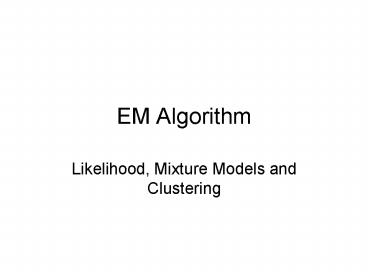EM Algorithm PowerPoint PPT Presentation
1 / 27
Title: EM Algorithm
1
EM Algorithm
- Likelihood, Mixture Models and Clustering
2
Introduction
- In the last class the K-means algorithm for
clustering was introduced. - The two steps of K-means assignment and update
appear frequently in data mining tasks. - In fact a whole framework under the title EM
Algorithm where EM stands for Expectation and
Maximization is now a standard part of the data
mining toolkit
3
Outline
- What is Likelihood?
- Examples of Likelihood estimation?
- Information Theory Jensen Inequality
- The EM Algorithm and Derivation
- Example of Mixture Estimations
- Clustering as a special case of Mixture Modeling
4
Meta-Idea
Probability
Model
Data
Inference (Likelihood)
A model of the data generating process gives rise
to data. Model estimation from data is most
commonly through Likelihood estimation
From PDM by HMS
5
Likelihood Function
Likelihood Function
Find the best model which has generated the
data. In a likelihood function the data is
considered fixed and one searches for the best
model over the different choices available.
6
Model Space
- The choice of the model space is plentiful but
not unlimited. - There is a bit of art in selecting the
appropriate model space. - Typically the model space is assumed to be a
linear combination of known probability
distribution functions.
7
Examples
- Suppose we have the following data
- 0,1,1,0,0,1,1,0
- In this case it is sensible to choose the
Bernoulli distribution (B(p)) as the model space. - Now we want to choose the best p, i.e.,
8
Examples
- Suppose the following are marks in a course
- 55.5, 67, 87, 48, 63
- Marks typically follow a Normal distribution
whose density function is - Now, we want to find the best ?,? such that
9
Examples
- Suppose we have data about heights of people (in
cm) - 185,140,134,150,170
- Heights follow a normal (log normal) distribution
but men on average are taller than women. This
suggests a mixture of two distributions
10
Maximum Likelihood Estimation
- We have reduced the problem of selecting the best
model to that of selecting the best parameter. - We want to select a parameter p which will
maximize the probability that the data was
generated from the model with the parameter p
plugged-in. - The parameter p is called the maximum likelihood
estimator. - The maximum of the function can be obtained by
setting the derivative of the function 0 and
solving for p.
11
Two Important Facts
- If A1,?,An are independent then
- The log function is monotonically increasing. x
y ! Log(x) Log(y) - Therefore if a function f(x) gt 0, achieves a
maximum at x1, then log(f(x)) also achieves a
maximum at x1.
12
Example of MLE
- Now, choose p which maximizes L(p). Instead we
will maximize l(p) LogL(p)
13
Properties of MLE
- There are several technical properties of the
estimator but lets look at the most intuitive
one - As the number of data points increase we become
more sure about the parameter p
14
Properties of MLE
r is the number of data points. As the number of
data points increase the confidence of the
estimator increases.
15
Matlab commands
- phat,cimle(Data,distribution,Bernoulli)
- phi,cimle(Data,distribution,Normal)
- Derive the MLE for Normal distribution in the
tutorial.
16
MLE for Mixture Distributions
- When we proceed to calculate the MLE for a
mixture, the presence of the sum of the
distributions prevents a neat factorization
using the log function. - A completely new rethink is required to estimate
the parameter. - The new rethink also provides a solution to the
clustering problem.
17
A Mixture Distribution
18
Missing Data
- We think of clustering as a problem of estimating
missing data. - The missing data are the cluster labels.
- Clustering is only one example of a missing data
problem. Several other problems can be formulated
as missing data problems.
19
Missing Data Problem
- Let D x(1),x(2),x(n) be a set of n
observations. - Let H z(1),z(2),..z(n) be a set of n values
of a hidden variable Z. - z(i) corresponds to x(i)
- Assume Z is discrete.
20
EM Algorithm
- The log-likelihood of the observed data is
- Not only do we have to estimate ? but also H
- Let Q(H) be the probability distribution on the
missing data.
21
EM Algorithm
Inequality is because of Jensens Inequality.
This means that the F(Q,?) is a lower bound on
l(?)
Notice that the log of sums is become a sum of
logs
22
EM Algorithm
- The EM Algorithm alternates between maximizing F
with respect to Q (theta fixed) and then
maximizing F with respect to theta (Q fixed).
23
EM Algorithm
- It turns out that the E-step is just
- And, furthermore
- Just plug-in
24
EM Algorithm
- The M-step reduces to maximizing the first term
with respect to ? as there is no ? in the second
term.
25
EM Algorithm for Mixture of Normals
Mixture of Normals
E Step
M-Step
26
EM and K-means
- Notice the similarity between EM for Normal
mixtures and K-means. - The expectation step is the assignment.
- The maximization step is the update of centers.
27
(No Transcript)

